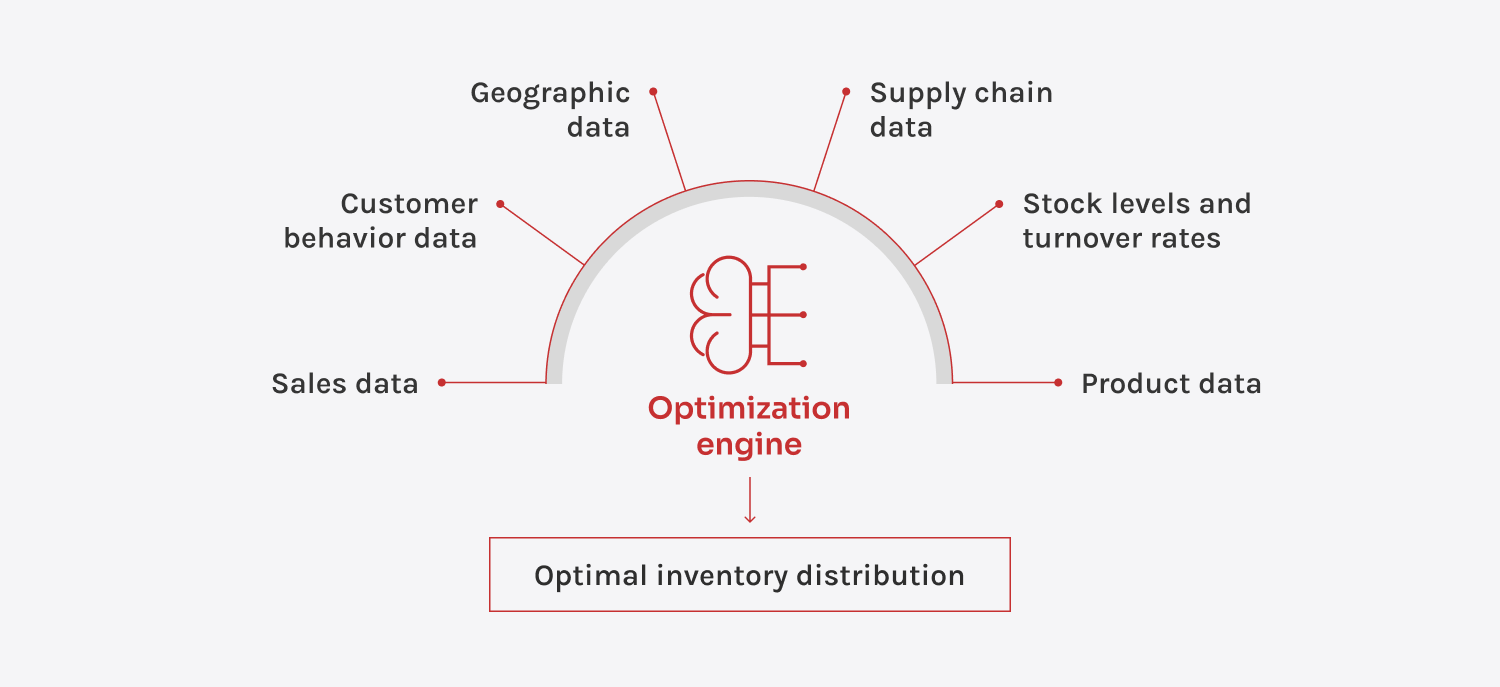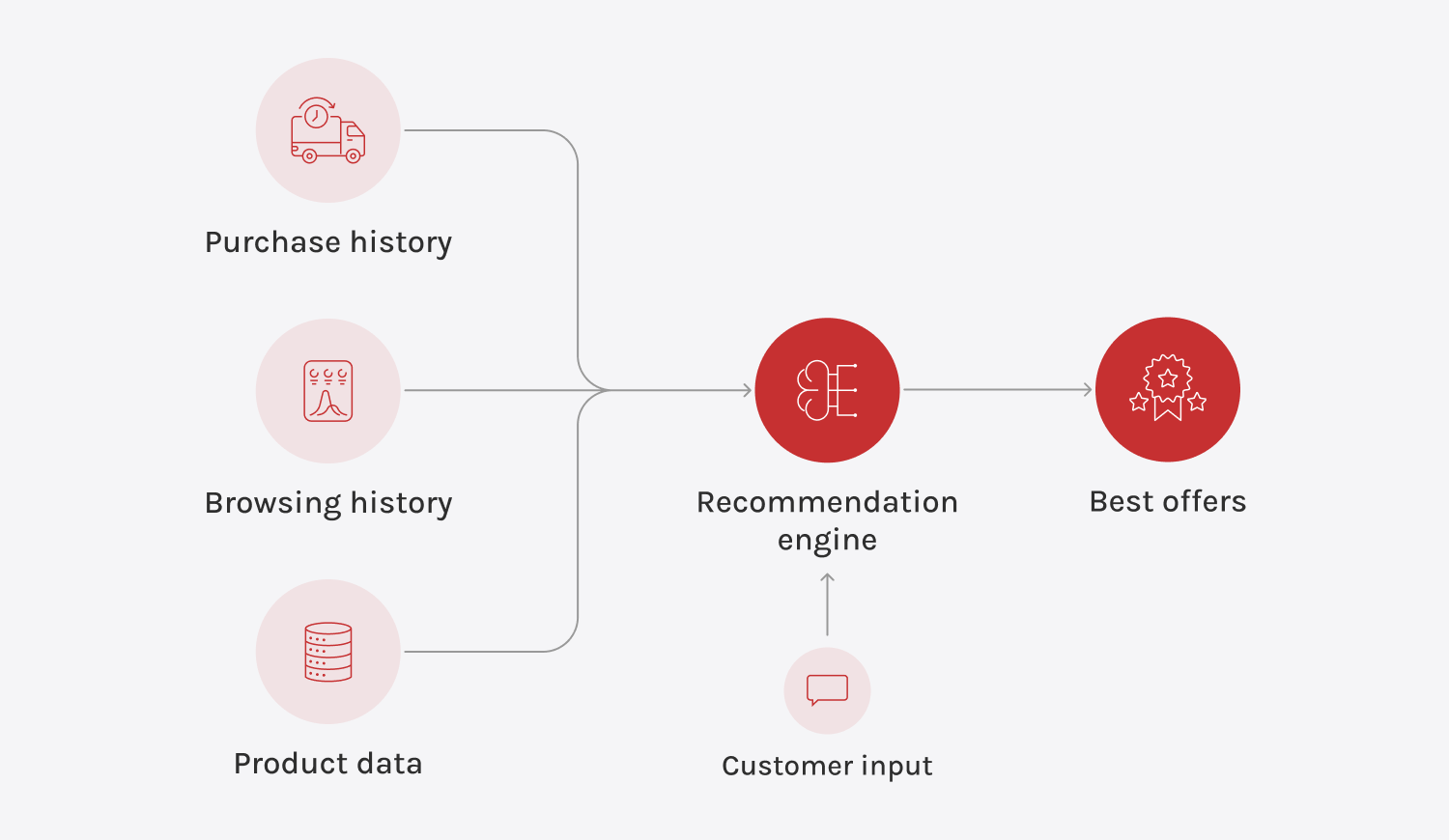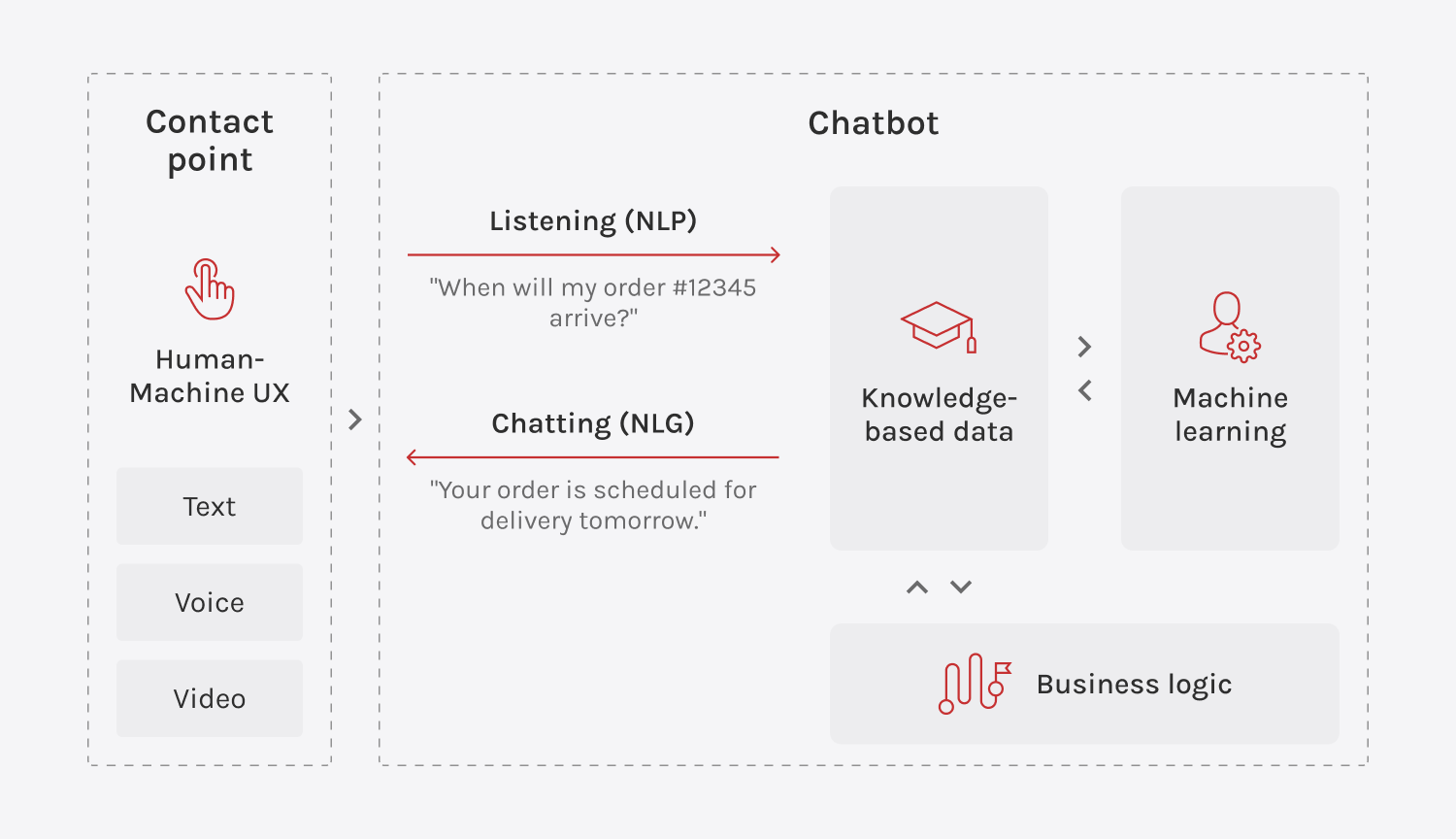Your message has been sent.
We’ll process your request and contact you back as soon as possible.
The form has been successfully submitted.
Please find further information in your mailbox.


In a world where predicting your customer’s next action has become essential, machine learning (ML) hopes to be a magic pill for businesses. ML looks at vast amounts of data to predict customer behaviors and optimize everything from personalization to inventory management.
In this article, we want to show you how machine learning and eCommerce work together and how machine learning can be used in eCommerce to boost your bottom line.
The global ML market was worth $19.20 billion in 2022 and is expected to jump to $225.91 billion by 2030.
Seems huge, right?
And it’s all because of a few key trends changing how businesses and customers interact in the online shopping world.
Shoppers today expect recommendations based on their past behavior, and when brands get it right, conversions go up. It’s all about making each shopping experience feel like it was tailor-made just for you.
As buyers increasingly expect to buy online and pick up in-store, or even browse in-store and buy online, the lines between digital and physical shopping continue to get blurred.
Platforms like Instagram and TikTok are turning into online marketplaces where you can buy products. This mix of entertainment and e-commerce makes shopping easier than ever.
More and more shoppers care about the planet and choose brands that share their values. From sustainable packaging to ethically sourced materials, green is the new black in the world of e-commerce.

Machine learning is fundamentally altering how e-commerce operates on the backend, allowing companies to analyze data and make better decisions in processes that are significantly more complex.
Up next, you’ll discover the key types of machine learning technology in eCommerce.
This kind of learning uses data that contains both input and output. For example, if you’re trying to predict whether a customer will leave or stay, the input could be things like their purchasing behavior, and the output is whether they stayed or left.
To make predictions, a model looks at patterns in past data, like how customers behaved before they churned, and uses those patterns to predict future behavior. Typical algorithms for this purpose include neural networks, logistics regression, decision trees, and support vector machines.
Instead of having labeled data (where we know the outcome), the machine is given raw, unlabeled data and has to find patterns or structures on its own. This is how unsupervised learning works.
Common algorithms used in unsupervised learning are K-means clustering, which groups similar items together, and Principal Component Analysis (PCA), which simplifies complex data by focusing on the most important features. These tools help the machine find hidden patterns without needing any predefined labels.
This type of learning is like teaching the machine through trial and error, similar to how humans learn from their mistakes. The machine interacts with its environment, takes actions, and receives feedback through rewards or penalties. Over time, it learns which actions lead to the best outcomes.
A frequently applied algorithm used in reinforcement learning is Q-learning, which helps the machine decide the best action to take in each situation based on past experiences.
This type of machine learning implies the system is trained to create new data that closely resembles the data it was trained on. Unlike other types of learning that focus on classifying or predicting, generative AI focuses on creating something new.
A popular model used for this is GANs (generative adversarial networks), which consists of two parts: one generates new data, and the other evaluates it to determine if it’s realistic enough. The two parts compete with each other, helping the model improve and create more convincing results over time. This approach is often used in creating images.
No matter what ML type, we can help you make it work for your eCommerce business
Machine learning in eCommerce primarily focuses on two key areas: improving internal business operations and elevating customer experiences. However, if we dig a bit deeper, we’ll see that the number of machine learning solutions for eCommerce extends far beyond.
See below for some machine learning examples in eCommerce that drive innovation and efficiency.
Customizing outdated marketing strategies would involve sending bulk emails to a customer base with predefined discounts. However, with the assistance of ML, discount strategies can differ across individuals depending on their past purchase behavior.
Sending people relevant offers makes it possible to increase customer loyalty, thanks to the high chances of an actual conversion. Customers love it when they get offers tailored to their interests, making them feel satisfied and turning them into repeat customers.
In platforms such as H&M, features like the personalized start page, Styleboard, and Visual Search rely on ML to recommend styles and matching items based on user data, including browsing history, trends, and images shared by other customers. ML algorithms also optimize checkout experiences by providing tailored payment and promotional options based on regional preferences and past customer behavior.
Let’s say you sell a range of products, from electronics to clothing. As time progresses, you begin to see portable speakers become a sales hit. Instead of waiting for human intervention, ML algorithms pop up. They monitor the demand in microseconds to determine the number of requests for the product in question and place a suggestion to increase the price when there is a spike. At the same time, ML is tracking the prices of your competitors and adjusting your prices accordingly.
To avoid overwhelming you with facts that lack proper evidence, consider a real-world example instead. Adspert’s pricing tool, created with AWS services like Amazon SageMaker, uses a machine learning model to dynamically reprice products based on factors like visibility, profit margins, and competition. This tool helps sellers keep their products visible, which ultimately boosts sales.
In another scenario, let’s imagine you have a loyal customer base. ML rewards that loyalty by offering additional value to your customers. It analyses when shoppers tend to buy the same product during a certain period, and sets a personalized price tag on it for that timeframe or offers tempting discounts.
Vendors use machine learning models for eCommerce to better understand sales and seasonal trends. The model allows them to accurately forecast demand which, in turn, helps avoid stock-outs of best-selling products (and upsetting customers) or overstocking low-selling items, which leads to excessive inventories and higher storage costs.
Removing the manual inventory tracking allows ML to advance automated reordering or stock redistribution policies.
Suppose a product offered at a particular location is selling rapidly, the system can reorder the product from suppliers or transfer stock from another location automatically. Additionally, ML can anticipate supply chain disruptions and even seek alternatives, such as switching suppliers or changing the shipping route.

Here’s one more example that should help guide your perspective. Walmart uses AI and machine learning to optimize inventory management and deliver an exceptional holiday shopping season. With historical data, predictive analytics, and advanced supply chain systems, Walmart lets customers find the products they need at the right time and place, all while keeping costs low.
When shoppers browse for products on your e-commerce platform, machine learning steps in like a savvy personal shopper. It tracks what they’ve clicked on, bought, and browsed before, then uses that data to tweak the search results.
So, if a customer has a soft spot for a particular brand of sneakers, an ML-powered site will show those shoes first, even if the search query is a little off or contains a typo. No more “Did you mean…?” pop-ups — just results that make sense instantly. If they suddenly start eyeing hiking boots or a new color, machine learning will shift gears, prioritizing those items in the search results. Over time, a site’s search function starts predicting what customers want and helping them find it faster.
Another real-world example to inspire and illustrate the point. Alibaba’s AI innovations, such as Taobao Wenwen, improve search results by offering personalized product recommendations, summarizing pros and cons, and providing multimedia content like videos and livestreams directly tied to search queries.
Machine learning in eCommerce analyzes customer behavior to establish normal patterns and swiftly detect any deviations or anomalies. For instance, it might flag transactions coming from an unexpected location or a sudden spike in high-value purchases.
When ML spots something suspicious, the system can take immediate action, like blocking the transaction or asking for extra verification, while letting legitimate customers shop freely. As fraudsters come up with new tactics, the system gets smarter by updating itself with fresh data.
This means eCommerce machine learning can reduce fraud, maintain customer trust, and focus on growth without constantly monitoring for threats. The perfect example of this is Amazon’s fraud detection ML solutions that evaluate risk instantly, giving businesses the power to act immediately. Suspicious activity can be blocked or denied on the spot, while trusted transactions move forward without a hitch.
Let’s take a deeper look at eBay. They invest millions annually in technologies, partnerships, and human resources to fight unlawful listings. The platform uses a combination of automated filters, image recognition, machine learning tools, and manual review by agents to proactively detect and remove problematic listings before they appear on the site.
An online store marketing strategy that performs well can be even more effective when machine learning e-commerce marketing is involved. For instance, ML algorithms can segment customers based on their buying habits, browsing history, and preferences, enabling businesses to send personalized offers or recommendations. It can also identify customers who are likely to churn by analyzing their activity and allowing businesses to take proactive steps, such as sending targeted retention offers.

Traditional A/B testing involves creating multiple versions of a webpage to determine which one performs better. It’s slow, tedious, and, frankly, a bit old-school. In contrast, machine learning accelerates the process. It dynamically tests and optimizes every little element on a page — the CTA button, the color scheme, or the layout — across diverse metrics like conversion rates and clicks.
And the best part? It can analyze and adapt continuously, identifying the best configuration faster than any human could. So, instead of running experiments for days or weeks, AI can fine-tune pages in minutes.
Picture placing an online order and receiving it at your doorstep almost instantly. That kind of speed is powered by machine learning that takes vast amounts of data — your shopping habits, inventory levels, even road conditions — and uses it to make quick decisions that optimize delivery times and logistics.
Take Walmart, for example. AI is used to curate product catalogs, analyze customer and shopping trends, and speed up logistics for third-party sellers using Walmart Fulfillment Services. Meanwhile, Amazon leverages generative AI to take things a step further. It’s optimizing delivery routes, improving warehouse robotics, and predicting where inventory should be placed to make same-day shipping a reality.
When customers upload images or take photos, ML algorithms analyze the visuals, match them with product catalogs, and suggest similar items. Visual recommendations also personalize the shopping experience based on a user’s past behavior. Virtual try-ons, powered by augmented reality (AR), allow customers to see how products like clothing or accessories would look on them before purchasing.
A good example here is the well-known L’Oréal Paris. The brand has partnered with beauty tech leader ModiFace to create an immersive virtual makeup simulator. The Virtual Try On feature is fueled by augmented reality to deliver realistic makeup simulations, helping users personalize their beauty experience.
Voice search lets customers find products using natural language commands. ML-driven voice assistants also provide real-time customer support, answering questions or helping with order tracking. Using Azure AI technologies, ASOS integrated language models and trend data to curate fashion selections instantly, emphasizing customer preferences and the latest fashion trends.
ML goes beyond simple keywords; it understands context, sarcasm, and emotional undertones, capturing sentiments that might otherwise be overlooked. This lets businesses address concerns faster and keep their finger on the pulse of trends, adjusting their strategies accordingly.
A good example here is Amazon, which has leveraged AI to help users quickly navigate and understand reviews, for example, by generating summary highlights that capture common themes and sentiments from reviews.
Social listening uses advanced tools to monitor social media and online platforms for relevant mentions, hashtags, or keywords. They can also analyze sentiment, similar to sentiment analysis, but with a broader focus on conversations around a topic rather than individual reviews or feedback.
Zara’s approach to understanding consumer needs and adapting its product offerings relies heavily on real-time customer feedback. The company uses data from social media and email surveys to gather insights directly from its customer base.
These chatbots rely on natural language processing (NLP) at their core, allowing them to understand and respond to user queries with accuracy.
For instance, if a customer asks, “When will my order #12345 arrive?” the chatbot identifies the intent (a question about delivery) and extracts the key information (the order number). It then fetches the relevant details from the database and provides a clear response, such as: “Your order is scheduled for delivery tomorrow.”

Innowise developed an AI-powered analytics platform that uses ML to optimize ad campaigns by matching user queries with the most relevant ads, improving keyword coverage and ad relevance. The solution increased ad clicks by 53%, reduced ad generation time by 25%, and achieved 92% coverage of user requests.
Our team integrated OpenAI’s GPT models into a no-code website-building platform, enabling AI-powered code generation and content creation. As a result, the solution reduced website customization time by 60%, improved SEO with optimized meta descriptions, and boosted search engine rankings by 17%.
We transformed the digital media ecosystem of our client, integrating advanced AI solutions to modernize web apps, upgrade user experience, and optimize operational efficiency. Key achievements include a 12% increase in monthly visitors and a 66% reduction in professional photography costs through text-to-image generative AI.
ML can optimize, personalize, and scale your business — let’s find what’s best for you!
Sure, eCommerce ML is powering personalized shopping experiences, predicting customer needs, and driving business decisions with incredible precision. But behind all the excitement lies a series of challenges that often go unnoticed.
Let’s take a closer look at the hurdles that machine learning e-commerce can face and what can be done to navigate these hurdles.
Challenge
Solution
ML models rely heavily on large volumes of high-quality data, but e-commerce businesses often struggle with incomplete and inconsistent datasets.
The initial cost of implementing machine learning algorithms for eCommerce might be high, but the efficiency and return on investment will undoubtedly make it valuable in the long run. Businesses can develop a competitive advantage, increase satisfaction rates, and earn more profit by integrating such tools. Our team would be delighted to help you use machine learning in eCommerce for your benefit.













Your message has been sent.
We’ll process your request and contact you back as soon as possible.

By signing up you agree to our Privacy Policy, including the use of cookies and transfer of your personal information.